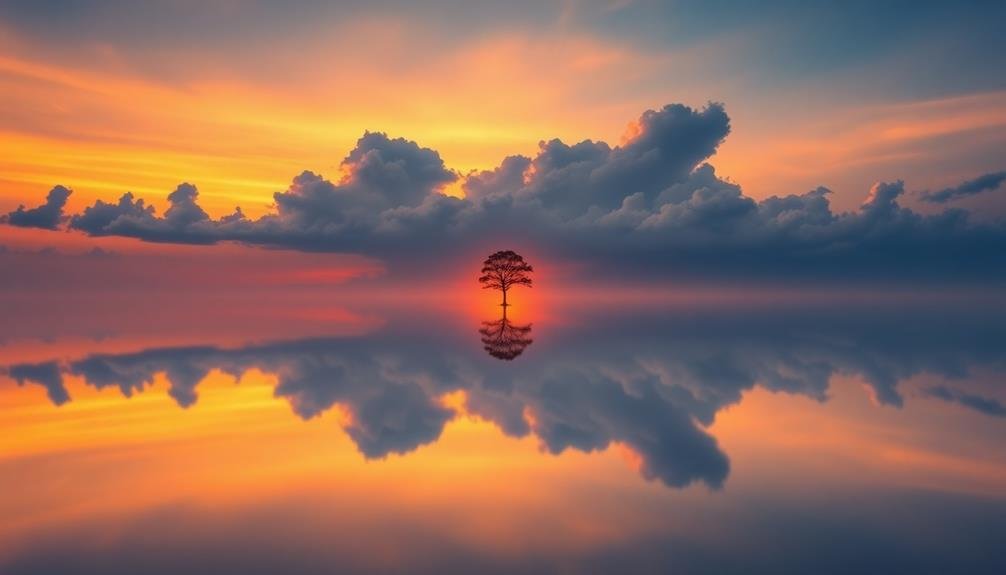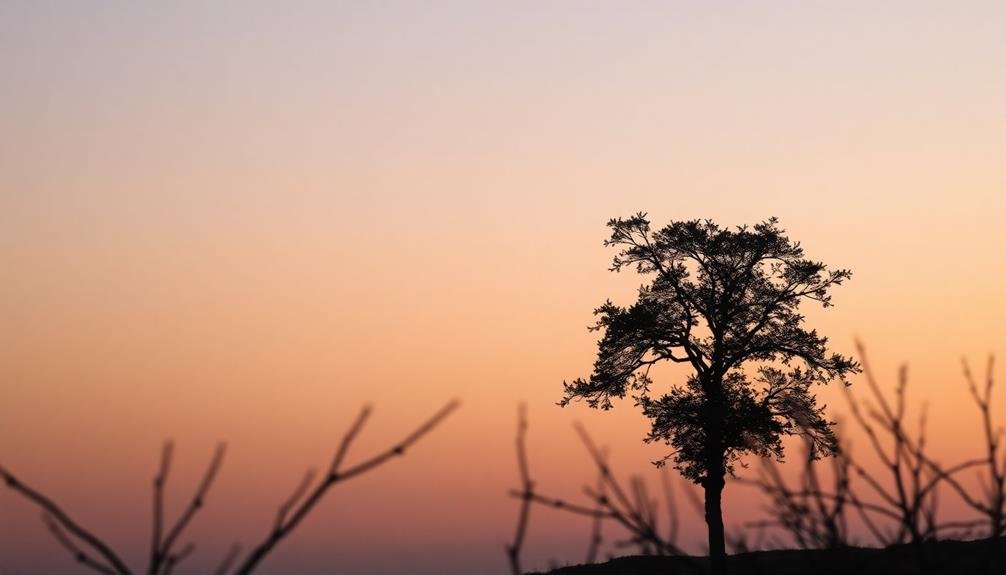Capture stunning minimalist sky shots with these simple composition tips: Apply the rule of thirds to balance your frame. Embrace negative space to emphasize the sky's vastness. Use leading lines to guide the viewer's eye. Incorporate symmetry and patterns for visual harmony. Frame your shot with natural elements. Create silhouettes against the sky for contrast. Make clouds your focal point. Experiment with horizon placement for different effects. Play with scale and perspective to convey the sky's grandeur. Finally, simplify your compositions by removing distracting elements. These techniques will help you create powerful, minimalist sky photographs that leave a lasting impression. Dig deeper to reveal even more ways to elevate your sky photography.
Key Takeaways
- Utilize the rule of thirds to position key elements and create balanced compositions.
- Embrace negative space to emphasize the sky's vastness and simplify the composition.
- Incorporate silhouettes or minimal foreground elements for contrast and visual interest.
- Experiment with horizon line placement to alter the focus and mood of the image.
- Use leading lines to guide the viewer's eye and create dynamic compositions.
Rule of Thirds

Imagine a grid dividing your frame into nine equal parts. This is the essence of the Rule of Thirds, a fundamental principle in photography composition.
When shooting minimalist sky scenes, this rule becomes even more essential. You'll want to place key elements along these lines or at their intersections to create a visually appealing and balanced image.
For sky shots, consider positioning the horizon along either the upper or lower third line. This decision depends on whether you want to emphasize the sky or the foreground.
Place the sun, moon, or other focal points at the intersections of these lines for maximum impact. Don't be afraid to leave large portions of the frame empty; negative space is a powerful tool in minimalist photography.
Negative Space

Negative space in minimalist sky photography can be your secret weapon.
You'll emphasize the sky's vastness by leaving large areas empty, creating a powerful sense of scale.
Balance this expansive negative space with a carefully placed foreground element to introduce visual tension and guide the viewer's eye through your composition.
Emphasize Vastness
Vast expanses of sky can set off your minimalist shots, drawing the viewer's eye to the subject. To emphasize vastness, position your main element low in the frame, allowing the sky to dominate the composition. This technique creates a sense of scale and isolation, enhancing the minimalist aesthetic.
Use a wide-angle lens to capture more of the sky and exaggerate the feeling of space. When shooting, look for clean, uncluttered horizons that won't distract from your subject. Consider including a single cloud or a flock of birds to add subtle interest without compromising the minimalist approach.
Pay attention to the sky's color and texture. A clear blue sky can create a stark backdrop, while wispy clouds or a gradient sunset can add depth. Experiment with long exposures to smooth out cloud movement, creating a soft, ethereal effect that emphasizes the sky's vastness.
Don't be afraid to leave large portions of your frame empty. This negative space reinforces the feeling of expansiveness and allows the viewer's imagination to fill in the gaps.
Balance With Foreground
Striking a balance between the sky and foreground elements is essential in minimalist sky photography. When composing your shot, consider the relationship between the vast expanse of sky and the objects in the foreground.
You'll want to create a harmonious balance that draws the viewer's eye while maintaining the minimalist aesthetic.
Use the rule of thirds to guide your composition, placing key elements along the imaginary grid lines. This technique can help you achieve a pleasing balance between the sky and foreground.
Don't be afraid to experiment with different ratios of sky to land or objects. Sometimes, a 90/10 split can create a dramatic effect, while other times, a 50/50 balance might work better.
Consider these tips when balancing your sky shots with foreground elements:
- Use silhouettes to create stark contrasts against the sky
- Incorporate leading lines to guide the viewer's eye
- Play with reflections in water or other surfaces
- Include a single, small object for scale and interest
- Utilize natural frames like trees or rock formations
Create Visual Tension
Creating visual tension is a powerful technique in minimalist sky photography. It's all about using negative space to create intrigue and draw the viewer's eye. To achieve this, you'll want to place your subject off-center, utilizing the rule of thirds. This asymmetry creates a sense of imbalance that keeps the viewer engaged.
Try positioning a lone cloud or bird at the edge of the frame, leaving vast empty sky as negative space. This contrast between the subject and the void creates a compelling visual narrative. You can also use architectural elements, like a single building or antenna, to break up an otherwise empty sky.
Experiment with different ratios of subject to negative space. A tiny subject in a vast expanse of sky can evoke feelings of isolation or insignificance, while a larger subject might suggest power or dominance.
Play with horizon lines, placing them extremely high or low in the frame to create unconventional compositions.
Leading Lines

Lines that lead the eye through a photograph can transform a simple sky shot into an enthralling composition. When capturing minimalist sky scenes, seek out natural or man-made elements that create strong directional lines. These could be roads, fences, power lines, or even cloud formations.
Position yourself to align these lines with your frame's edges or corners, guiding the viewer's gaze towards the sky or a focal point within it.
Experiment with different angles and perspectives to maximize the impact of leading lines. Try shooting from a low angle to emphasize the convergence of lines towards the horizon. Alternatively, capture lines that curve or zigzag through the frame for a more dynamic effect.
Remember, the goal is to use these lines to enhance the overall composition and draw attention to the sky's beauty.
Here are some elements that can serve as effective leading lines in minimalist sky shots:
- Long, straight roads stretching into the distance
- Rows of trees or telephone poles
- Architectural features like bridges or buildings
- Contrails left by airplanes
- Natural formations such as coastlines or mountain ridges
Symmetry and Patterns

When capturing minimalist sky shots, you'll want to focus on symmetry and patterns.
Look for balanced cloud formations that create a sense of harmony in your composition, and consider carefully placing the horizon line to enhance the overall symmetry.
If you're near water, don't forget to use reflections to create mirror-like patterns that can add depth and intrigue to your minimalist sky photographs.
Balanced Cloud Formations
Framed by a minimalist aesthetic, balanced cloud formations can transform an ordinary sky shot into an enchanting masterpiece. When composing your image, look for symmetry in cloud patterns or evenly distributed formations across the frame. This balance creates a sense of harmony and visual interest, drawing the viewer's eye across the entire composition.
To capture balanced cloud formations effectively, consider the following tips:
- Wait for the right moment when clouds naturally align in a pleasing arrangement
- Use the rule of thirds to position key cloud elements along imaginary grid lines
- Experiment with different focal lengths to adjust the scale and spacing of clouds
- Incorporate negative space to emphasize the cloud formations and create contrast
- Look for reflections in water bodies to double the impact of balanced clouds
Pay attention to the shapes, sizes, and textures of the clouds. Seek out complementary forms that create a sense of equilibrium within the frame.
Don't be afraid to crop your image in post-processing to fine-tune the balance. Remember, minimalist sky photography is about simplicity and impact.
Horizon Line Placement
The horizon line serves as a powerful compositional tool in minimalist sky photography. When capturing sky shots, you'll want to carefully consider where you place this line within your frame. A common approach is to use the rule of thirds, positioning the horizon along the upper or lower third of the image. This creates a pleasing balance and draws the viewer's eye into the scene.
For a more dramatic effect, try placing the horizon line very low or high in the frame. A low horizon emphasizes the vastness of the sky, perfect for showcasing expansive cloud formations or vibrant sunsets. Conversely, a high horizon line can create a sense of intimacy, focusing on foreground elements like reflections in water or interesting textures on the ground.
Experiment with symmetry by centering the horizon line. This technique works well for reflections, creating a mirror-like effect that adds visual interest to your minimalist sky shots.
You can also use the horizon to create leading lines, guiding the viewer's eye through the image. Remember, there's no one-size-fits-all approach – let the scene and your artistic vision guide your horizon line placement.
Reflections in Water
Amid the tranquil beauty of water, reflections offer a powerful tool for creating symmetry and patterns in minimalist sky photography. When you're shooting near lakes, ponds, or even puddles, you'll find endless opportunities to capture stunning mirror images of the sky. These reflections can double the impact of your composition, creating a sense of balance and harmony that's visually enchanting.
To make the most of water reflections in your minimalist sky shots:
- Look for still water surfaces to achieve the clearest reflections
- Experiment with different angles to find the perfect symmetry
- Use a polarizing filter to enhance or reduce reflections as needed
- Consider including minimal elements like a single tree or boat for added interest
- Try capturing partial reflections for a more abstract approach
When composing your shot, pay attention to the balance between the sky and its reflection. You can create a perfect mirror image by placing the horizon line in the center of your frame, or experiment with different ratios to emphasize either the sky or the reflection.
Don't forget to adjust your camera settings to properly expose both the sky and the water, ensuring you capture all the nuances of light and color in your minimalist masterpiece.
Framing With Natural Elements

Enhance your minimalist sky shots by incorporating natural elements as frames. Use trees, branches, or rock formations to create a natural border around the sky, drawing the viewer's eye to the main subject. Look for interesting shapes or silhouettes that complement the sky's mood and color palette. Experiment with positioning these elements asymmetrically for a more dynamic composition.
Consider the following natural framing elements and their effects:
| Element | Effect | Best Time |
|---|---|---|
| Trees | Vertical lines, organic shapes | Dawn/Dusk |
| Branches | Delicate, intricate patterns | Midday |
| Mountains | Strong, horizontal lines | Sunset |
| Rocks | Texture, rugged contrast | Golden hour |
| Clouds | Soft, ethereal frames | Overcast days |
When framing with natural elements, pay attention to negative space. Allow enough room for the sky to breathe and maintain its minimalist quality. Use the rule of thirds to position your framing elements effectively, placing them along the gridlines or at intersection points. Don't be afraid to crop tightly, emphasizing the interplay between the frame and the sky. Experiment with different angles and perspectives to find the most compelling composition. Remember, the goal is to enhance the sky's beauty without overwhelming it.
Minimalist Color Palettes

Countless stunning sky shots rely on a carefully curated color palette to achieve their minimalist appeal. When capturing the sky, focus on simplifying your color scheme to create a powerful visual impact.
Look for natural color harmonies, such as complementary or analogous combinations, that occur during different times of the day or weather conditions.
Consider shooting during golden hour or blue hour to take advantage of the soft, warm hues or cool, tranquil tones.
Explore monochromatic compositions by isolating a single color and its variations. You'll often find that less is more when it comes to color in minimalist sky photography.
To enhance your minimalist color palettes:
- Experiment with different white balance settings
- Use gradient filters to balance exposure and enhance colors
- Look for subtle color shifts in the sky
- Incorporate negative space to emphasize the chosen palette
- Edit selectively to maintain a cohesive color scheme
Silhouettes Against the Sky

When capturing silhouettes against the sky, you'll create striking contrast for dramatic effect.
Focus on clean, distinct shapes to maximize the impact of negative space. You can use buildings, trees, or people as your subjects, ensuring their outlines are crisp and well-defined against the backdrop.
Contrast for Dramatic Effect
Silhouettes against the sky create powerful contrast in minimalist sky shots. By emphasizing the stark difference between light and dark elements, you'll add depth and drama to your images.
Experiment with exposing for the sky, allowing foreground objects to become dark silhouettes. This technique works particularly well during golden hour or blue hour when the sky's colors are most vibrant.
To maximize contrast, focus on clean lines and distinct shapes. Look for objects with recognizable outlines, such as trees, buildings, or people.
Position yourself to capture these elements against the brightest part of the sky for the most striking effect. Don't be afraid to underexpose your shot slightly to enhance the contrast even further.
Here are five tips to boost contrast in your minimalist sky shots:
- Use a low ISO to maintain image quality
- Shoot in RAW format for greater editing flexibility
- Experiment with different angles and perspectives
- Include negative space to emphasize your subject
- Try black and white conversion for ultimate contrast
Shapes and Negative Space
Building on the contrast techniques, shapes and negative space play a key role in creating compelling minimalist sky shots. When composing your image, look for clean, distinct silhouettes against the sky. Trees, buildings, or even people can serve as powerful subjects. The key is to find shapes that are easily recognizable and have interesting outlines.
Position your subject carefully within the frame to maximize the impact of negative space. This empty area around your subject draws attention to the main element and creates a sense of calm and simplicity. Don't be afraid to leave large portions of the sky empty; this emptiness is what gives minimalist shots their power.
Experiment with different angles and perspectives to find the most striking shape. Sometimes, shooting from a low angle can make a subject appear more imposing against the sky. You can also try partial silhouettes, where only part of the subject is dark against the sky, adding depth and intrigue to your composition.
Remember to keep your shots simple. One or two well-defined shapes are often more effective than a cluttered scene. By focusing on shapes and negative space, you'll create minimalist sky shots that are both visually striking and emotionally impactful.
Clouds as Focal Points

Clouds can serve as compelling focal points in minimalist sky photography. They offer a range of shapes, textures, and patterns that can add interest to an otherwise empty canvas. When shooting clouds as focal points, look for unique formations or isolated clouds that stand out against a clear sky. Experiment with different angles and compositions to emphasize the cloud's shape and create a sense of balance within the frame.
Consider the following tips when using clouds as focal points:
- Seek out unusual cloud formations, such as lenticular or mammatus clouds
- Use long exposures to capture cloud movement and create ethereal effects
- Position the cloud off-center to create a more dynamic composition
- Experiment with different times of day to capture varying light and color
- Incorporate negative space to enhance the cloud's impact
Pay attention to the surrounding sky as well. A gradient of colors during sunrise or sunset can complement the cloud's form and add depth to your image.
Don't be afraid to simplify your composition by removing distracting elements and focusing solely on the cloud and sky. Remember, in minimalist photography, less is often more.
Horizon Placement

Horizon placement plays a crucial role in minimalist sky photography. When composing your shot, you'll need to decide where to position the horizon line. The rule of thirds is a good starting point, but don't be afraid to break it for dramatic effect.
Placing the horizon in the lower third of the frame emphasizes the sky, making it the dominant element. This works well when you've got interesting cloud formations or vibrant colors in the upper atmosphere.
Conversely, positioning the horizon in the upper third draws attention to the foreground, which can be effective if you've got interesting elements like reflections in water or textured ground.
For a bold, unconventional look, try placing the horizon dead center. This creates a symmetrical composition that can be visually striking, especially with a clean, uncluttered skyline.
You can also experiment with extreme placements, like having the horizon at the very bottom or top of the frame.
Scale and Perspective

Scale and perspective can dramatically enhance your minimalist sky shots. When composing your image, consider how the size and placement of elements in your frame can create a sense of depth and intrigue.
Use foreground objects to add scale, making the sky appear vast and expansive. Experiment with different focal lengths to alter the perceived distance between elements, creating unique visual relationships.
Don't be afraid to play with proportions. A tiny silhouette against an enormous sky can evoke feelings of awe and insignificance. Conversely, filling most of the frame with a cloud formation can emphasize its texture and form.
Remember, minimalism is about simplicity, so choose your compositional elements carefully.
To create compelling scale and perspective in your minimalist sky shots:
- Incorporate a small, recognizable object for scale
- Use leading lines to draw the eye into the frame
- Position yourself at different heights to change viewpoints
- Experiment with wide-angle and telephoto lenses
- Utilize negative space to emphasize your subject
Frequently Asked Questions
What Camera Settings Are Best for Minimalist Sky Photography?
You'll want to use a wide-angle lens, set your aperture between f/8 and f/11 for sharpness, and keep your ISO low. Use a slower shutter speed for smooth clouds, and don't forget a tripod for stability.
How Do You Handle Exposure Challenges in High-Contrast Sky Scenes?
You'll want to use bracketing to capture multiple exposures. Combine them in post-processing or use graduated neutral density filters. Expose for the highlights and bring up shadows later. Don't forget to shoot in RAW format.
Which Lens Focal Lengths Work Well for Minimalist Sky Compositions?
You'll find wide-angle lenses (16-35mm) excellent for expansive sky views. For more focused compositions, try a standard lens (50mm). If you're after isolated cloud details, telephoto lenses (70-200mm) can work wonders. Don't be afraid to experiment!
Are There Specific Weather Conditions Ideal for Minimalist Sky Photography?
You'll find clear skies with a few clouds ideal for minimalist sky photography. Look for days with high pressure systems, wispy cirrus clouds, or lone cumulus formations. Early morning or late afternoon light can enhance the effect.
How Can You Create Interesting Minimalist Sky Shots in Urban Environments?
You can create enchanting minimalist sky shots in urban settings by using building silhouettes, framing with architectural elements, and incorporating negative space. Look for clean lines, geometric shapes, and interesting cloud formations to add visual interest.
In Summary
You've now got the tools to create stunning minimalist sky shots. Remember, these tips are just starting points – don't be afraid to experiment and break the rules. As you practice, you'll develop your unique style. Keep your eyes on the sky, watch for changing light and weather, and always have your camera ready. With patience and persistence, you'll capture breathtaking images that showcase the sky's timeless beauty and vastness.

As educators and advocates for responsible drone use, we’re committed to sharing our knowledge and expertise with aspiring aerial photographers.




Leave a Reply